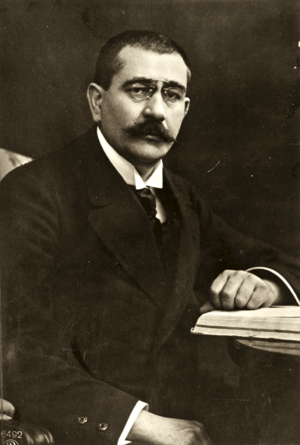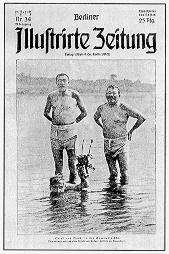Gustav Noske facts for kids
Quick facts for kids
Gustav Noske
|
|
|---|---|

Gustav Noske, c. 1918
|
|
| Defence Minister | |
| In office 13 February 1919 – 22 March 1920 |
|
| Chancellor | Philipp Scheidemann Gustav Bauer |
| Preceded by | Office established |
| Succeeded by | Otto Gessler |
| Personal details | |
| Born | 9 July 1868 Brandenburg an der Havel, Kingdom of Prussia, North German Confederation |
| Died | 30 November 1946 (aged 78) Hanover, Lower Saxony, Allied-occupied Germany |
| Political party | SPD |
Gustav Noske (born 9 July 1868 – died 30 November 1946) was an important German politician. He was a member of the Social Democratic Party (SPD). Noske became the very first Minister of Defence for the Weimar Republic. This was the government of Germany after World War I. He held this job from 1919 to 1920. Noske is a debated figure because he used the army and special military groups to stop uprisings in 1919.
Contents
Early Life and Political Beginnings
Gustav Noske was born in Brandenburg an der Havel, Prussia, on 9 July 1868. His father, Karl Noske, was a weaver. His mother, Emma Noske, worked as a manual laborer. Gustav went to school from 1874 to 1882.
After school, he learned to be a basket maker. He traveled to different cities like Halle and Amsterdam as a young worker. In 1884, Noske joined the Social Democratic Party (SPD). He also became a member of a trade union. By 1892, he was chosen to lead the SPD in Brandenburg.
In 1891, he married Martha Thiel. They had three children: one son and two daughters.
From 1897 to 1902, Noske worked as an editor for SPD newspapers. He wrote for papers in Brandenburg and Königsberg. Later, from 1902 to 1918, he was the main editor for the Volksstimme newspaper in Chemnitz.
In 1907, Noske was elected to the Reichstag of the German Empire. This was the German parliament. He stayed a member until 1918. In the SPD, he became an expert on military, navy, and colonial issues. He believed Germany should have colonies. He was known as a reformist, meaning he wanted to achieve political goals by working within the existing system.
Noske During World War I
During the First World War, Gustav Noske was a central figure in the SPD. He, along with Friedrich Ebert and Philipp Scheidemann, supported the war. They saw it as a way to defend Germany. Noske also supported the government's war loans.
He worked to give the Reichstag (parliament) more power. From 1916 to 1918, he spoke for a special group. This group looked into how the military bought supplies. Noske helped to make sure these dealings were fair. He also helped the parliament gain more authority.
German Revolution and Civil Unrest
In October 1918, Noske joined the SPD's leadership in the Reichstag. When sailors started a revolt in Kiel in November, the chancellor, Prince Max von Baden, sent Noske there. His job was to negotiate an end to the uprising. The sailors welcomed Noske. They even chose him as their leader, seeing him as an ally.
Noske quickly brought order back to Kiel. He helped the officers regain control. The sailors who stayed in Kiel went back to their duties. Both Max von Baden and the new chancellor, Friedrich Ebert, were very happy with Noske's success. Noske stayed in Kiel until December 1918.
After a small revolt by the Volksmarinedivision in Berlin, the Independent Social Democrats (USPD) left the government. This government was called the Council of the People's Deputies. On 30 December, Noske joined the government. He was put in charge of military matters.
In January 1919, Noske played a key role in stopping the "Spartacist revolt". Some historians see this event as an attempt by Berlin workers to regain control. The uprising began when the head of the Berlin police, a USPD member, was fired. The USPD called for a protest. Many thousands of people, some armed, gathered in the city. They took over newspaper offices and train stations. Some USPD and KPD leaders decided to try and overthrow the government.
However, the crowds did not take over government buildings. The military support they hoped for did not arrive. Ebert started talking with the uprising's leaders. But he also prepared for a military response. Noske was made commander of the Freikorps. These were special volunteer military groups. Ebert also worked to get the regular army on the government's side. From 9 to 12 January, Noske's forces put down the uprising.
A few days later, on 15 January 1919, members of a Freikorps group captured and killed the socialist leaders Karl Liebknecht and Rosa Luxemburg. Noske had ordered that Liebknecht's phone be watched. He also made sure Liebknecht's movements were reported.
On 19 January 1919, elections were held for the National Assembly. This assembly met in Weimar. On 13 February 1919, President Ebert appointed a new government. Philipp Scheidemann led it. Noske became the Reichswehrminister, or Minister of Defence.
Throughout the first half of 1919, Ebert and Noske continued to use strong military force. They used both the regular army and the Freikorps to stop left-wing uprisings across Germany.
As Minister of Defence, Noske helped reorganize the military. This happened after the collapse of 1918. He supported signing the Treaty of Versailles. This treaty greatly limited Germany's military power. By mid-1919, some army leaders began planning a military takeover. Noske was part of these talks. He refused to become a dictator after a coup. However, he did not stop the officers who made these offers. He also did not tell other government members about their plans.
On 20 January 1920, the Treaty of Versailles became active. It limited the German army to 100,000 men. On 28 February 1920, Noske followed orders from an Allied military group. He dissolved two Freikorps groups, "Ehrhardt" and "Loewenfeld". General Walther von Lüttwitz, a top army general, refused to obey. This led to the Kapp Putsch.
To restore order, Noske asked General Hans von Seeckt to order the army to stop the putsch. Von Seeckt refused. The government had to leave Berlin. However, a general strike was called by unions and the SPD. Also, government workers refused to recognize the new leader, Wolfgang Kapp. This quickly ended the coup.
One condition for ending the strike was Noske's resignation. Some in the SPD were also unhappy with how he handled the putsch. He resigned on 22 March 1920. Otto Gessler took his place. Noske was the last Social Democrat to hold this position in the Weimar Republic.
Later Life and Passing
After leaving his government role, Noske became the Governor of the Province of Hanover in 1920. He became more traditional in his political views. He supported Paul von Hindenburg in the presidential elections of 1925 and 1932.
However, because he was a Social Democrat, the Nazi government removed him from his job in 1933. Noske then moved to Frankfurt. In 1944, the Gestapo (Nazi secret police) arrested him. They suspected he was involved in the 20 July plot to kill Adolf Hitler. He was sent to the Ravensbrück concentration camp. Allied troops later freed Noske from a Gestapo prison in Berlin.
Gustav Noske died in Hanover on 30 November 1946. He had a stroke while getting ready for a lecture tour in the United States. He is buried in Hanover.
See also
 In Spanish: Gustav Noske para niños
In Spanish: Gustav Noske para niños


